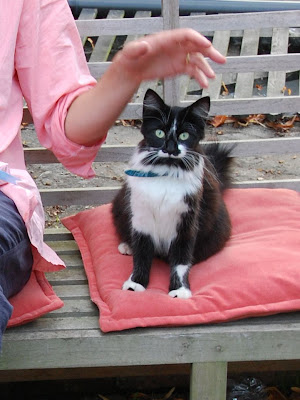
Members of the Gloucestershire Churches Environmental Justice Network met today at Rodborough, for a visit to a remarkably energy-efficient building. We were shown round by its owner, Mike Hillard. On his
website, he describes himself as a
pioneering environmental architect and designer, his enthusiasm and commitment being born out of his conviction that
We are facing total environmental catastrophe.Tranquility House is certainly not low tech: never, in a private home, have I seen so many gismos, nor so many computer screens flashing away:
hibernate doesn't seem to be a relevant term to Mike (let alone
shut down) - nor indeed does the concept of virtual tourism, judging from the number of Lonely Planet guides in his bookshelves, his beautiful photographs of tribesmen laid out on his second floor work table, curtain materials carried back from Uzbekistan and the Amazon, not to mention the odd spear leaning casually up against a doorway. Mike speaks with passion about the generosity of primitive people in Africa.
Apart from its enormous two-storey conservatory/solar room, the house looks conventional enough from the outside. No sign of a domestic wind turbine here nor photovoltaic cells - both decried, along with combined heat and power, compact fluorescent light bulbs, multi-foil insulation, ground source heat pumps (assuming you are using a gas boiler), biomass, biodiesel. It was a somewhat controversial meeting, you can imagine!
What impresses are the costs he quotes for water and energy consumption: space heating, £30 p.a.; water heating, £8.25. The walls - two feet thick or so - have a U-Value of 0.12. My photograph shows the black-painted copper tubes in the solar room, collecting heat for water on its way up to the cylinder. This room, filled with huge ferns, orchids and banana trees, provides 19 degrees C in Winter daylight: its internal walls are the thermal mass soaking up the almost horizontal sunlight, the room's warmth being ventilated into the main house.
The house is not just about low energy use: each room features unique curtain rods, hollow tubes filled with macaroni, sunflower seeds or something similar. PVC lines the walls of one of the bathrooms, and the floors and staircase are all made from different timbers, the most spectacular being horse chestnut.
A fascinating visit even for someone as scientifically illiterate as I am, so thanks to the hecticly busy Mike Hillard for sparing us time: after our animated dialogue he ran around to ensure that we saw all aspects of the building, talking ten to the dozen as he went. The name "Tranquility House" is obviously aspirational.
 As I said, I am just off to walk some more of the Compostela Way: this calvary stands by the Cathedral in Eauze, where we ended our pilgrimage walk in 2007.
As I said, I am just off to walk some more of the Compostela Way: this calvary stands by the Cathedral in Eauze, where we ended our pilgrimage walk in 2007.









